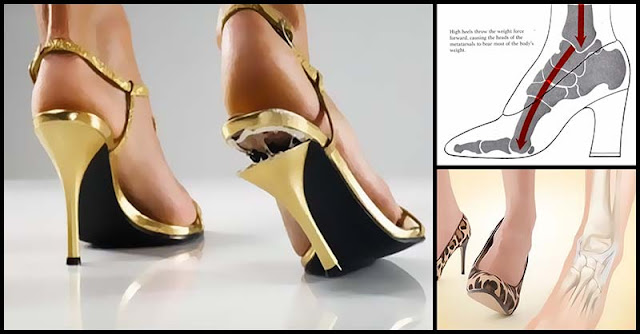Are you a fan of high-heeled shoes? Do you feel that your day is incomplete without your favorite stilettos? Well, high heels seem to be the gold standard in women’s footwear for everything.
There is no doubt the high heels are stylish. However, wearing a pair can entirely change the way your body moves, including your pelvis, hips, and legs resulting in weakness, muscle pain, and other negative side effects.
Though a lot of women know that heels are the main culprit in millions of foot and ankle complaints, they still wear their favorite high-heeled shoes.
What Is Happening In Your Body When You Wear Heels?
Wearing high heels have serious consequences. It causes your stomach to push forward and your butt to push back, thereby placing extra pressure on your lower back and affecting the distribution of weight on your spine.
According to studies, every time you put your high heels on, it results in one vertebra pushing forward in front of another, which is really painful.
Also, high heels harm your legs because it causes your calf muscles to adjust to the different posture you take thus resulting in a tighten and shorten muscles. This only means that your muscle will not be able to relax.
The Unnatural Foot Position Of Heels
We are meant to walk heel first. Majority of our weight is placed on our heels while pressing on to our forefoot quickly before repeating. However, a different process is applied when you wear high heels. Putting on a pair moves your weight off your heels. The unnatural amount of pressure is placed on your forefoot. This can be harmful as it will result in weakened heels and strain on your forefeet.
Dangers Associated With High Heels
High heels, regardless of how beautiful they are, have always a negative impact on your body.
Falling And Sprained Ankles
Wearing a pair of flat shoes enables your weight to spread evenly between the ball of your foot and the heel, with little pressure on your ankle. But when you wear heels, your ankle receives a lot of pressure and is forced to become the fulcrum for your entire body. Due to this, falls as well as sprained or twisted ankles are very common.
Joint Pain
Heels lack any significant shock absorption and stop your foot from naturally rotating as you walk because they’re forced into a straight and unbending position. Due to this, your knee absorbs the brunt of every step and this can lead to severe joint pain and exacerbation of arthritis symptoms.
Ingrown Toenails
Since most heels have a pointy or almond-shaped toe, it’s the biggest and littlest toes that take a lot of the pressure as they press against the sides and the end of the shoe. It crushes your toe and leads to ingrown toenails.
Shortened Achilles Tendon
Women who always wear heels were found to shorten their Achilles tendon. A heel in a lifted position creates a physiological change in the tendons and muscles around the ankles. That means, when barefoot or wearing flats and shoes that cause the heel to reach the ground, the wearer can feel immense pain and stretch.
Callouses
Pushing your feet into too-tight shoes, such as pointy-toe shoes, would only create pressure on the sides of your toes and feet which can lead to hardening of the skin over time.
Lower Back Pain
Heels cause your pelvis to push forward when you walk or stand, placing tremendous pressure on the lower back and causing lingering pain.
If you will still be wearing high heels despite their adverse impacts on your body then try to consider these tips:
- Don’t go for the pointed toe.
- Try and set your limit to two inches.
- Buy a wide variety of shoes and vary your footwear day to day.
- Buy shoes in the afternoon when feet are at their largest.
- Avoid wearing high heels for a long period of time.
- Opt for shoes with leather insoles to keep the foot from slipping.
- Stretch legs muscles before and after putting them on.









